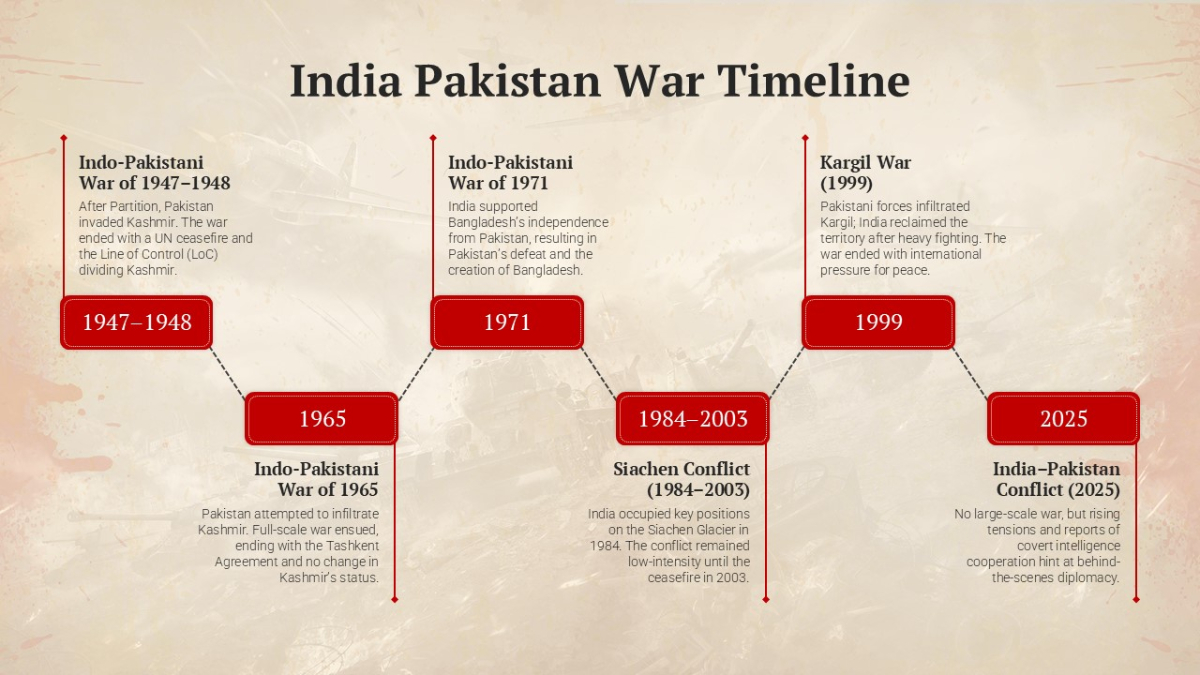Now Reading: A Timeline of Conflict: India-Pakistan Wars
-
01
A Timeline of Conflict: India-Pakistan Wars
A Timeline of Conflict: India-Pakistan Wars

New Delhi, November 20, 2025: The rivalry between India and Pakistan, born from the 1947 partition of British India, has resulted in four major wars and numerous smaller armed conflicts. The primary point of contention remains the disputed territory of Kashmir, a flashpoint that continues to dominate the geopolitical dynamics of South Asia.
Here is a summary of the four full-scale wars fought between the two nuclear-armed neighbours:
1. The First Kashmir War (1947-1948)
- Cause: Triggered immediately after Partition when Pakistan-backed tribal militias invaded the princely state of Jammu and Kashmir. The state’s Hindu ruler, Maharaja Hari Singh, acceded to India in exchange for military assistance.
- Outcome: The war ended with a United Nations-brokered ceasefire. This established the Line of Control (LoC), which divided the region, with India controlling roughly two-thirds (Jammu and Kashmir) and Pakistan controlling the rest (Azad Kashmir and Gilgit-Baltistan). The fundamental dispute remained unresolved.
2. The Second Indo-Pakistani War (1965)
- Cause: Pakistan launched Operation Gibraltar, sending infiltrators into Indian-administered Kashmir to instigate an insurgency. India responded with a full-scale offensive across the international border.
- Outcome: The short, intense war (17 days) ended in a military stalemate. A ceasefire was declared, followed by the Tashkent Agreement (mediated by the Soviet Union), which restored the pre-war positions but, again, failed to resolve the Kashmir issue.
3. The Bangladesh Liberation War (1971)
- Cause: This war was rooted in the political and ethnic crisis in East Pakistan (now Bangladesh). Following a brutal military crackdown by West Pakistan, millions of refugees fled to India. India intervened in support of the Bengali independence movement (Mukti Bahini).
- Outcome: A decisive victory for India. The war concluded in just 13 days with the surrender of over 90,000 Pakistani troops, leading to the creation of the independent nation of Bangladesh. The Shimla Agreement (1972) formalised the LoC as the de facto boundary.
Also Read: Light to Fire: Festival Launch Mishap Goes Viral
4. The Kargil War (1999)
- Cause: Pakistani soldiers and paramilitary forces infiltrated and occupied strategic mountain posts on the Indian side of the Line of Control in the Kargil district of Kashmir.
- Outcome: India launched Operation Vijay to push back the intruders using a combination of infantry, artillery, and airpower. Under intense international pressure, particularly from the US, Pakistan was forced to withdraw. India successfully reclaimed all positions, marking an Indian victory and cementing the LoC’s status.
The Nuclear Context
Since both nations became declared nuclear powers in 1998, the conflict dynamic has shifted. While the risk of all-out conventional warfare is arguably deterred by the nuclear overhang, tensions continue to flare through cross-border skirmishes and military standoffs following major terrorist attacks, maintaining South Asia’s status as one of the world’s most precarious geopolitical regions.










